Shelli Bautista loves her job, but it can be tough. As a registered nurse working in a cardiac care unit at Long Beach Memorial Hospital, her days are filled with challenging moments as she cares for people who are fearful, confused or in pain.
Her training prepared her for that. But she sometimes dips into another well of strength on those long days — an experience that grew from her high school participation in the Holocaust Art and Writing Contest at Chapman University.
It was 2008, and for an assignment made by her English teacher, Teresa Hill (M.A. ’01), Bautista studied the videotaped testimonies of several Holocaust survivors, looking for the one that would inspire her essay. Bautista was struck by the testimony of Mila Page, who had been a young medical student when the war erupted. Page was one of the “Schindler Jews” and among a group of women mistakenly transported to Auschwitz-Birkenau rather than to Schindler’s factory. Throughout it all, Page remained hopeful.
“That’s what I wrote about, that whole train ride,” Bautista says. The essay won first place in the high school prose category, and Bautista recalls a “blur” of excitement — reading her work from the stage of Memorial Hall and meeting Page in person. But the enduring takeaway from the experience goes much deeper.
“It helps me put things in perspective. It’s given me hope that I can do things in my little corner of the world to make a difference in other people’s lives, especially in the work that I do. I meet so many different people — people from different walks of life. It can be challenging,” Bautista says. “(Mila’s) story, her belief that compassion and understanding is the key to making sure that what happened in the Holocaust doesn’t happen again, has helped me with what I do. It reminds me that each one of us has a role to play.”
ENDURING IMPACT
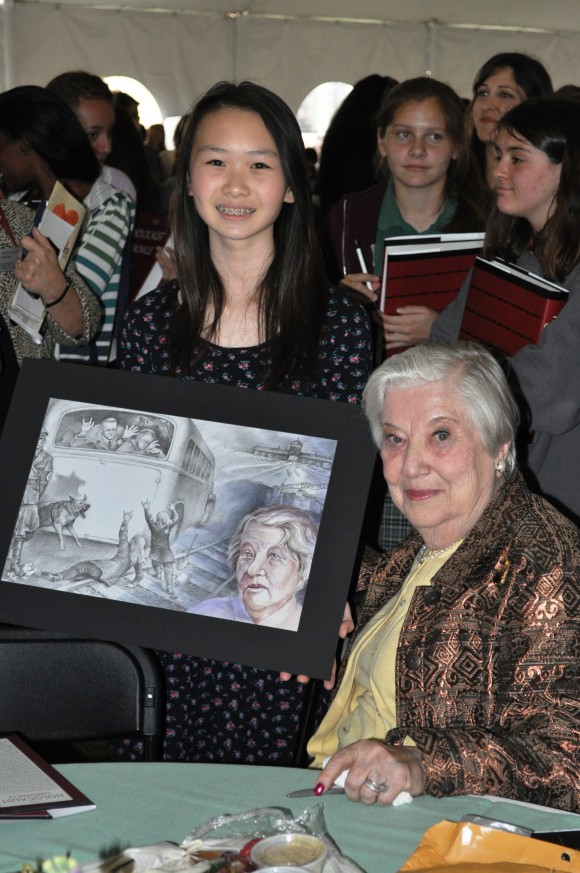
Lessons of sacrifice and character are at the heart of the contest, which marked its 15th year this spring with 175 participating middle and senior high schools from across the United States. With support from the Rodgers Center for Holocaust Education, Wilkinson College of Humanities and Social Sciences, The 1939 Society, The Samueli Foundation and Dana and Yossie Hollander, the program includes speakers, lunch, a traditional musical performance by the Orange County Klezmers, copies of The Holocaust Chronicle for each participant and transportation for survivors.
A few years back, Chapman finance and marketing major Bayli Anderson ’14 was among those youngsters as a finalist in the middle school art category. Now she’s a student assistant working at Chapman’s Rodgers Center for Holocaust Education, home to myriad world- class programs, including a lecture series, annual visits for conversations with students by Nobel Peace Prize Laureate Elie Wiesel, the Sala and Aron Samueli Holocaust Memorial Library and other educational and commemorative events. The Department of History also collaborates with the center on its widely respected minor in Holocaust history.
“Even now, working at the library, I learn so much every day,” Anderson says. “I just love that they still have the opportunity for students to come onto campus and meet survivors.”
But each year the number of Holocaust survivors that attends the contest award ceremony grows smaller. And each year the number of middle and high school students who gather to meet them grows larger.
It’s a numbers game that is an affecting fact of life for the contest, says Marilyn Harran, Ph.D., founder of the contest and director of the Rodgers Center for Holocaust Education.
“The contest has grown and engaged more and more students and teachers. Some schools now have their own contests to choose the entries that are forwarded to us,” Harran says.
The march of time makes the effort ever more urgent.
VITAL VOICES
Still, even as they increasingly arrive with slow, shuffling walks and canes in hand, the survivors and witnesses remain committed to sharing their stories, again and again. Following the award ceremony in Memorial Hall they sit at open tables in a large tent that covers the Bert C. Williams Lawn for an informal lunch and conversation with contest entrants who made it into the finals.
Students line up for photo opportunities and one-on-one chats. All clutch copies
of the commemorative book Holocaust Survivors: The Indestructible Spirit, made possible by Louis Weber and Publications International. The aging men and women turn to the pages where their particular story is printed and sign their names with short notes and appeals to “always remember.”While survivors say they enjoy the students’ energy and interest, the day is not a lark. Often in the many moments of meeting, hands clasp and eyes meet, bridging generations. The survivors honor memories of lost loved ones and plant seeds of compassion for the future.
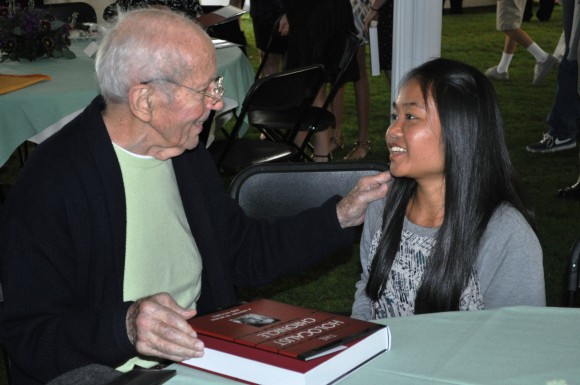
Survivor and resistance fighter Curt Lowens, who immigrated to the United States after the war and launched a successful career as a screen and television actor, says the day is meaningful to him because it is a chance to touch the future.
“To us it means so much that the memory is retained and is studied and is basically, hopefully, leading to — well, it’s utopian if I say ‘a better world’ — but at least a better neighborhood,” Lowens says.
INSPIRING AND TEACHING
To enter, students study the videotaped testimonies of Holocaust survivors and choose one for the inspiration of either a work of poetry, prose, art or film, a new category added this year. The contest attracts entries from across the United States and now even includes international participants. Christine Perez, an English teacher from Bernardo Yorba Middle School in Yorba Linda, has had students enter the contest since its inception. Not all students can win — just three of her 20 entrants made it to the finals this year — but the experience is valuable for all, Perez says.
“It’s very important. I teach The Diary of Anne Frank, and to keep that history alive for these kids, and particularly in middle school, is very important because we want them to be more aware of what happened,” Perez says.
It’s an experience eighth-grader Hailey Shi from Walnut, Calif., says she will never forget. Hailey had studied a videotaped oral history interview with Holocaust survivor Billauer. From it she was inspired to paint a picture of the moment Billauer and her sister were separated from their parents, both of whom were deaf and taken away by Nazis and killed in a mass execution. Hailey met Billauer at the reception.
“Meeting her was very wonderful,” Hailey said. “I hope that people generations from now will still hear it and understand that it was a very hard time to live through, but it will never be forgotten.”
Photo at top: “Every Little Bit Helped,” by Joshua Sands, Acaciawood College Preparatory Academy. Inspired by the testimony of Regina Lewin.
>>MORE: Read an excerpt from “In Rememberance There Is Only Kindness.”
Highlights from the 2013 Holocast Art and Writing Contest:
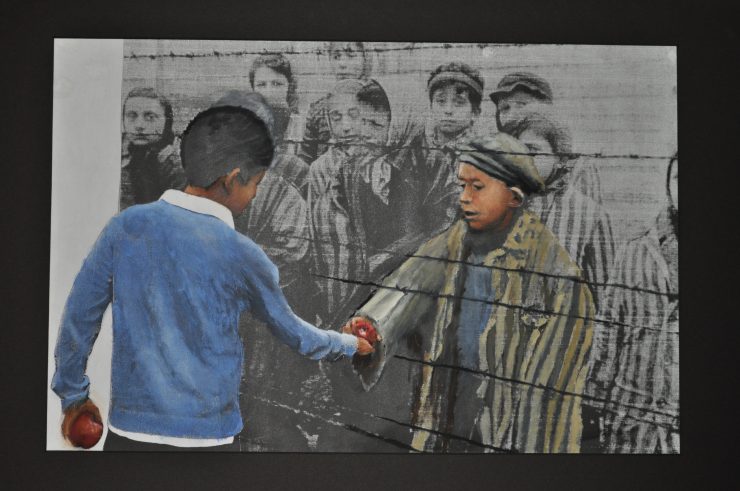

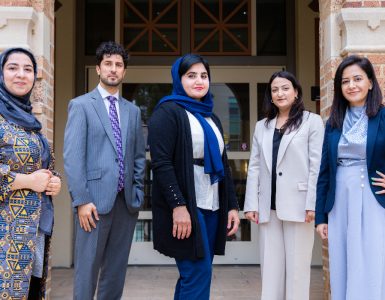
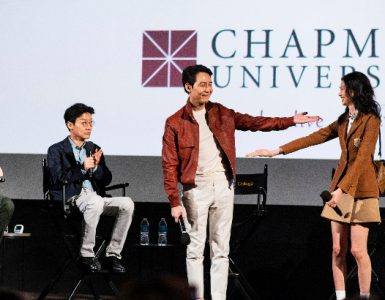

Add comment